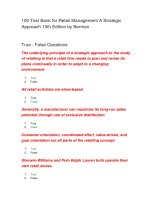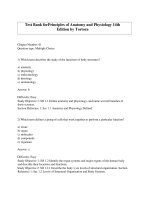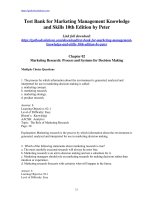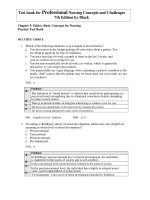Test bank for radiologic science for technologists physics biology and protection 10th edition by bushong
Bạn đang xem bản rút gọn của tài liệu. Xem và tải ngay bản đầy đủ của tài liệu tại đây (37.83 KB, 6 trang )
buy this full document at
Bushong: Radiologic Science for Technologists, 10th Edition
Chapter 01: Essential Concepts of Radiologic Science
Test Bank
MULTIPLE CHOICE
1. Matter is measured in _____.
a. kilograms
b. joules
c. electron volts
d. rems
ANS: A
Matter is measured in kilograms
DIF: Easy
matter.
REF: page 3
OBJ: Recognize the unit of measurement for
2. Energy is measured in _____.
a. kilograms
b. joules
c. electron volts
d. B or C
ANS: D
Energy is measured in joules or electron volts
DIF: Moderate
energy.
REF: page 4
OBJ: Recognize the unit of measurement for
3. Atoms and molecules are the fundamental building blocks of _____.
a. energy
b. radiation
c. matter
d. gravity
ANS: C
Atoms and molecules are the fundamental building blocks of matter.
DIF: Moderate
matter.
REF: page 3
OBJ: List the fundamental building blocks of
4. Ice and steam are examples of two forms of _____.
a. matter
buy this full document at
Full file at />b. radiation
c. energy
d. work
ANS: A
Ice and steam are examples of two forms of matter.
DIF: Difficult
REF: page 4
OBJ: Describe states of matter.
5. The formula E=mc2 is the basis for the theory that led to the development of _____.
a. x-rays
b. electromagnetic radiation
c. nuclear power
d. cathode ray tubes
ANS: C
The formula E=mc2 is the basis for the theory that led to the development of nuclear
power.
DIF: Difficult
equivalence.
REF: page 5
OBJ: Understand the theory of energy-mass
6. Radio waves, light, and x-rays are all examples of _____ energy.
a. nuclear
b. thermal
c. electrical
d. electromagnetic
ANS: D
Electromagnetic energy includes radio waves, light, and x-rays as well as other parts of
the spectrum.
DIF: Difficult
REF: page 4
OBJ: List types of electromagnetic energy.
7. A moving object has _____ energy.
a. potential
b. kinetic
c. nuclear
d. electromagnetic
ANS: B
A moving object has kinetic energy.
DIF: Moderate
REF: page 4
OBJ: Identify various forms of energy.
8. What is the removal of an electron from an atom called?
Copyright © 2013 by Mosby, an imprint of Elsevier Inc.
Full file at />a.
b.
c.
d.
ionization
pair production
irradiation
electricity
ANS: A
The removal of an electron from an atom is called ionization.
DIF: Moderate
REF: page 5
OBJ: Understand ionization of matter.
9. Ionizing radiation is capable of removing _____ from atoms as it passes through the
matter.
a. neutrons
b. protons
c. electrons
d. ions
ANS: C
Ionizing radiation is capable of removing electrons from atoms as it passes through the
matter.
DIF: Moderate
REF: page 5
OBJ: Describe the process of ionization by ionizing radiation.
10. The energy of x-rays is _____.
a. thermal
b. potential
c. kinetic
d. electromagnetic
ANS: D
X-rays are a form of electromagnetic energy.
DIF: Difficult
REF: page 5
OBJ: List the category of energy of x-rays.
11. The biggest source of man-made ionizing radiation exposure to the public is _____.
a. atomic fallout
b. diagnostic x-rays
c. smoke detectors
d. nuclear power plants
ANS: B
Medical x-ray exposure is the biggest source of man-made radiation.
DIF: Difficult
REF: page 6
OBJ: Understand the relative intensity of ionizing radiation from various sources.
Copyright © 2013 by Mosby, an imprint of Elsevier Inc.
Full file at />12. In the United States, we are exposed to _____ mR/year of ionizing radiation from the
natural environment.
a. 0-5
b. 5-20
c. 20-90
d. 100-300
ANS: C
We are exposed to 20-90 mR/yr of ionizing radiation from natural environmental sources
in the United States.
DIF: Difficult
REF: page 6
OBJ: Understand the amount of natural environmental ionizing radiation to which the
public is exposed in the United States.
13. The basic quantities measured in mechanics are _____, _____, and _____.
a. volume, length, meters
b. mass, length, time
c. radioactivity, dose, exposure
d. meters, kilos, seconds
ANS: B
The basic quantities measured in mechanics are mass, length, and time.
DIF: Easy
mechanics.
REF: page 12
OBJ: List the basic quantities measured in
14. An example of a derived quantity in mechanical physics is a _____.
a. meter
b. second
c. dose
d. volume
ANS: D
Volume is a derived unit.
DIF: Moderate
quantity.
REF: page 12
OBJ: Recognize an example of a derived
15. _____ is a special quantity of radiologic science.
a. Mass
b. Velocity
c. Radioactivity
d. Momentum
Copyright © 2013 by Mosby, an imprint of Elsevier Inc.
Full file at />ANS: C
Radioactivity is a special quantity of radiologic science.
DIF: Easy
REF: page 12
OBJ: Recognize radioactivity as a special quantity of radiologic science.
16. Exposure is measured in units of _____.
a. becquerel
b. sieverts
c. meters
d. grays
ANS: D
Exposure is measured in units of grays.
DIF: Moderate
measurement.
REF: page 14
OBJ: Understand units of radiation
17. Today, radiology is considered to be a(n) _____ occupation.
a. safe
b. unsafe
c. dangerous
d. high-risk
ANS: A
Today, radiology is considered to be a safe occupation because of effective radiation
protection practices.
DIF: Moderate
radiology.
REF: page 10
OBJ: Understand the risk of an occupation in
18. What does ALARA mean?
a. All Level Alert Radiation Accident
b. As Low As Reasonably Achievable
c. Always Leave A Restricted Area
d. As Low As Regulations Allow
ANS: B
ALARA means As Low As Reasonably Achievable.
DIF: Moderate
REF: page 10
OBJ: Understand the meaning of ALARA.
19. Computed tomography was developed in the _____.
a. 1890s
b. 1920s
c. 1970s
Copyright © 2013 by Mosby, an imprint of Elsevier Inc.
Full file at />d. 1990s
ANS: C
Computed tomography was developed in the 1970s.
DIF: Moderate
REF: page 10
OBJ: Relate history of the development of computed tomography.
20. Filtration is used to _____.
a. absorb low-energy x-rays
b. remove high-energy x-rays
c. restrict the useful beam to the body part imaged
d. fabricate gonadal shields
ANS: A
Filtration is used to absorb low-energy x-rays.
DIF: Moderate
REF: page 10
OBJ: Relate history of the development of computed tomography.
Copyright © 2013 by Mosby, an imprint of Elsevier Inc.









